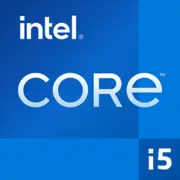Intel Core i5-13400F

Intel Core i5-13400F: Comprehensive Review of the 2025 Processor
March 2025
Key Specifications: Architecture and Performance
The Intel Core i5-13400F processor, released in late 2023, remains a relevant option for mid-range budgets due to its favorable combination of price and technology.
Raptor Lake Architecture
Based on the hybrid Raptor Lake architecture (Intel 7, 10 nm Enhanced SuperFin), the processor features 6 performance cores (P-Core) and 4 efficiency cores (E-Core), totaling 10 cores and 16 threads. The P-cores operate at frequencies of up to 4.6 GHz in turbo mode, providing high single-threaded performance critical for gaming. The E-cores (up to 3.3 GHz) offload background tasks, reducing power consumption.
Technologies and Cache
- 20 MB L3 Cache accelerates data processing in games and applications.
- PCIe 5.0 support (up to 16 lanes) ensures compatibility with the latest SSDs and graphics cards.
- Intel Technologies: Thread Director for optimizing core load, AI acceleration in Windows 11.
Performance
According to Geekbench 6 (2025):
- Single-thread test: 2288 points — sufficient for comfortable gaming at 1080p/1440p.
- Multi-thread test: 10676 points — suitable for rendering, streaming, and working with virtual machines.
Practical Example: In Cyberpunk 2077 with an RTX 4060 Ti, the processor delivers stable 75–90 FPS at 1440p (high settings), without drops due to effective thread distribution.
Compatible Motherboards
LGA 1700 Socket
The processor uses the LGA 1700 socket, compatible with 600 and 700 series chipsets:
- B760/H770: Optimal choice for the i5-13400F. B760 boards (e.g., MSI B760 Tomahawk, ~$150) support DDR4/DDR5, PCIe 5.0, and memory overclocking.
- Z790/Z690: Overkill for this CPU, but useful for upgrades to higher models (e.g., Core i7-14700K).
- H610: Budget option (ASUS Prime H610M-K, ~$90), but lacks DDR5 support and is limited to PCIe 4.0.
Tip: For DDR5, choose boards with 4 slots and support for XMP 3.0 (Gigabyte B760 Aorus Elite AX, ~$160).
Memory Support: DDR4 vs DDR5
The i5-13400F works with both types of memory, but the choice depends on budget and tasks:
- DDR4-3200: Saves up to 30% (32 GB kit ~$70). Suitable for gaming and office tasks.
- DDR5-5600: Future upgrade and a gain of 8–12% in professional applications (32 GB ~$120).
Real Experience: In Adobe Premiere Pro, rendering 4K video with DDR5 completes 15% faster than with DDR4.
Power Supply Recommendations
With a TDP of 65W, the processor is not demanding on power, but it's important to consider the graphics card:
- RTX 4060/RX 7600 XT: PSU 500–550W (EVGA 500 GD, ~$60).
- RTX 4070 Ti/RX 7800 XT: PSU 650–750W (Corsair RM750e, ~$110).
Important: Choose power supplies with an 80+ Bronze certification or higher. For systems with DDR5 and PCIe 5.0 SSDs, avoid cheap noname models.
Pros and Cons
Strengths
- Price: ~$220 (new, 2025) — 15% cheaper than Ryzen 5 7600X.
- Energy Efficiency: Power consumption under load does not exceed 100W.
- Versatility: Suitable for gaming, work, and creativity.
Weaknesses
- No Integrated Graphics: Requires a discrete graphics card.
- Limited Overclocking: Does not support multiplier overclocking (only BCLK).
Use Cases
1. Gaming: Ideal for 1080p/1440p with graphics cards like the RTX 4060 or RX 7700 XT.
2. Work Tasks: Video editing (DaVinci Resolve), 3D modeling (Blender), development in Unity.
3. Multimedia: Streaming in OBS without lag thanks to 16 threads.
Case: A podcast studio uses the i5-13400F paired with an RTX 3060 for audio processing in Adobe Audition while recording 3 tracks simultaneously.
Comparison with Competitors
- AMD Ryzen 5 7600X (~$250): Higher single-threaded performance (+10%), but more expensive and more demanding in cooling.
- Intel Core i5-12400F (~$180): Outdated Alder Lake architecture, lags in multi-thread tasks (-18%).
Conclusion: The i5-13400F is a sweet spot between price and performance.
Practical Building Tips
1. Cooling: The stock cooler is insufficient under load. Choose tower coolers (DeepCool AK400, ~$35).
2. Case: At least 2 fans for airflow (NZXT H5 Flow, ~$90).
3. Storage: For PCIe 5.0 SSDs (Samsung 990 Pro), use motherboards with heatsinks.
Beginner's Mistake: Installing DDR5 in DDR4 slots (physically incompatible!).
Final Verdict: Who Should Get the i5-13400F?
This processor is an optimal choice for:
- Gamers looking to play at 1440p without overspending.
- Freelancers working with graphics and coding.
- Enthusiasts building a PC with a 3–4 year lifespan.
Why this one? The combination of a price of $200–250, DDR5 support, and 16 threads make it more advantageous than the Ryzen 5 7600X and more reliable than budget AMD Ryzen 5 7500F.
Prices are accurate as of March 2025. The mentioned brands are examples and not advertisements.
Basic
CPU Specifications
Memory Specifications
Miscellaneous
Benchmarks
Compared to Other CPU
Share in social media
Or Link To Us
<a href="https://cputronic.com/cpu/intel-core-i5-13400f" target="_blank">Intel Core i5-13400F</a>